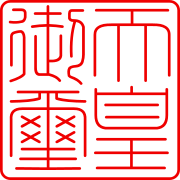Privy Seal of Japan


The Privy Seal of Japan is one of the national seals and is the Emperor of Japan's official seal. It is cubic, and its inscription 天皇御璽 ("The Emperor's Imperial Seal") is written in seal script (篆書 tensho). It has two lines of vertical writing, with the right-hand side containing the characters 天皇 (Tenno, emperor), and on the left-hand side containing the characters 御璽 (Gyoji, imperial seal). The seal is printed on Imperial rescripts, proclamation of sentences of laws, cabinet orders, treaties, instruments of ratification, ambassadors' credentials and their dismissal documents, documents of general power of attorney, consular commissions, letters authorizing foreign consuls, letters of appointment or dismissal of government officials, whose appointment requires the Emperor's attestation, and appointment documents and documents of the Prime Minister and Chief Justice, and their respective dismissals.[1]
History
The history of the Privy Seal of Japan dates back to the Nara period. Although it was originally made from copper, it was manufactured from stone in 1868 (Meiji) and later, was made from pure gold. The present Privy Seal is pure gold and is about 3 sun (about 9 cm) in size and weighs 4.5 kg. The master-hand of the seal was Abei Rekido (安部井 櫟堂; 1805-1883), of Kyoto. He was commissioned to manufacture the State Seal of Japan within one year, in 1874 (Meiji 7). When not in use, the seal is kept in a leather bag. The seal is used with special cinnabar seal ink specially made by the National Printing Bureau.
If the State Seal or the Privy Seal are illegally reproduced, the penalty is at least two years or more of terminable penal servitude according to the first clause of Article 164 of the Criminal Code of Japan.[2]